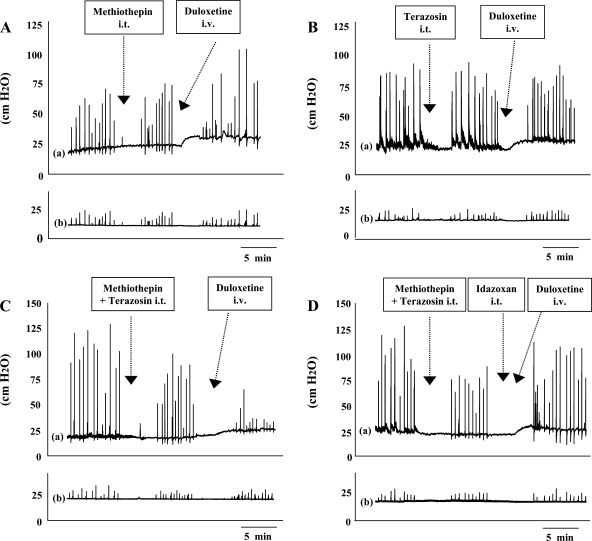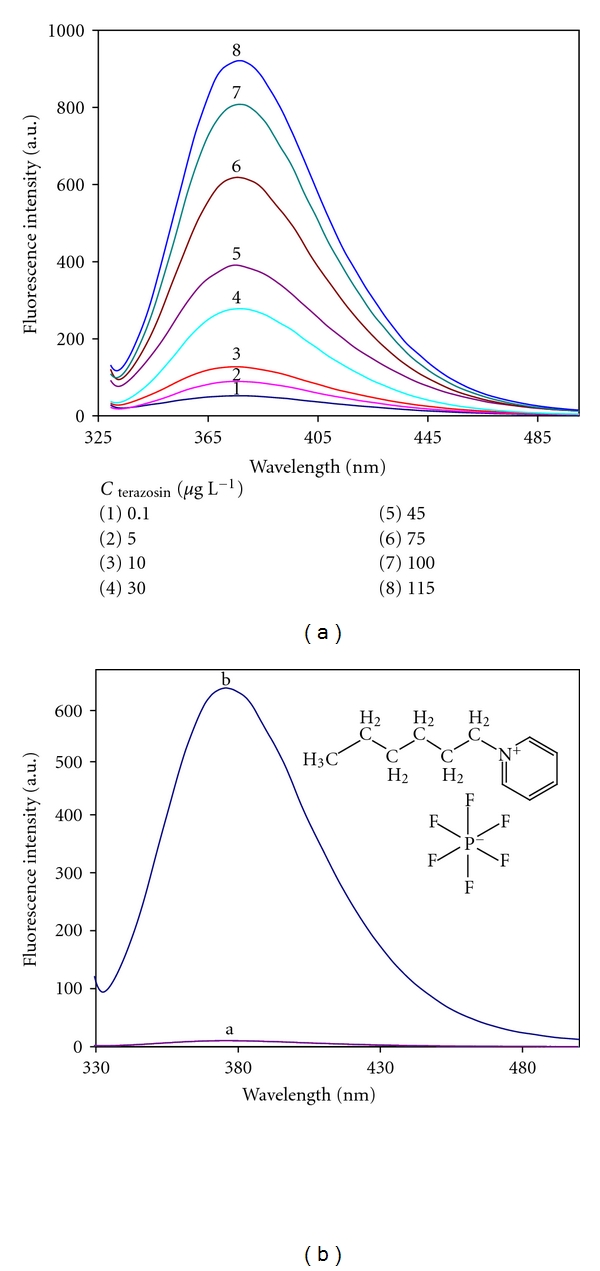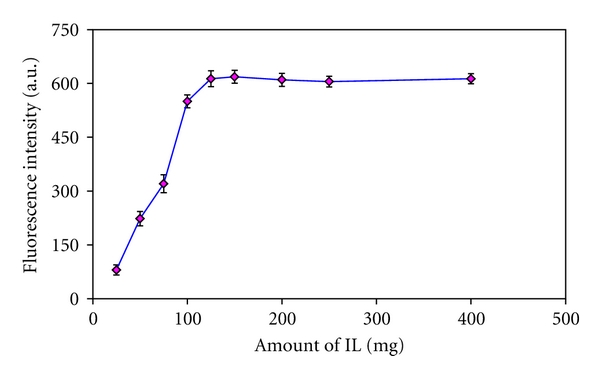
| Size | Price | Stock | Qty |
|---|---|---|---|
| 100mg |
|
||
| 250mg |
|
||
| 500mg |
|
||
| 1g |
|
||
| Other Sizes |
|
Purity: ≥98%
Terazosin HCl (A45975; A 45975; A-45975; Vasocard; Hyprin), the hydrochloride salt of Terazosin (racemate of terazosin), is a potent and selective α1-adrenoceptor antagonist which is used for treatment of symptoms of an enlarged prostate (BPH- benign prostatic hyperplasia). Terazosin produces cytotoxicity with an IC50 of greater than 100 μM in PC-3 and human benign prostatic cells. In cultured human umbilical vein endothelial cells, terazosin also effectively inhibited tube formation and vascular endothelial growth factor-induced proliferation (IC50 9.9 and 6.8 μM, respectively).
| Targets |
α1-adrenoceptor
|
||
|---|---|---|---|
| ln Vitro |
|
||
| ln Vivo |
|
||
| Cell Assay |
PC-3 cells and primary cultures of human benign prostatic cells were used in this study. The cytotoxic effect was examined using the 3-(4,5-dimethylthiazol-2-yl)-2,5-diphenyltetrazolium bromide assay and lactate dehydrogenase release reaction. The in vivo angiogenic effect was determined in nude mice models, followed by histological examination and quantification by the hemoglobin detection assay. In vitro determination of cell migration, proliferation and tube formation was performed in cultured human umbilical vein endothelial cells. RESULTS terazosin induced cytotoxicity in PC-3 and human benign prostatic cells with an IC50 of more than 100 microM. The positive terminal deoxynucleotidyl transferase deoxyuridine triphosphate nick end labeling and lactate dehydrogenase release reaction was associated with terazosin induced cytotoxicity, indicating apoptotic and necrotic cell death. Furthermore, cytotoxicity due to terazosin action was not a common characteristic of a quinazoline based structure. Terazosin significantly inhibited vascular endothelial growth factor induced angiogenesis in nude mice with an IC50 of 7.9 microM., showing that it had a more potent anti-angiogenic than cytotoxic effect. Terazosin also effectively inhibited vascular endothelial growth factor induced proliferation and tube formation in cultured human umbilical vein endothelial cells (IC50 9.9 and 6.8 microM., respectively).
Conclusions: Together our data suggest that terazosin shows direct anti-angiogenic activity through the inhibition of proliferation and tube formation in endothelial cells. This action may partly explain the in vivo antitumor potential of terazosin[3].
In the current study, various identification techniques were employed to ascertain the mode of action of the cytotoxic effect. With terminal deoxynucleotidyl transferase deoxyuridine triphosphate nick end labeling, apoptotic cells can be identified in situ. After PC-3 cells were treated with 100 μM terazosin for 12 hours, the results indicate a positive response. |
||
| Animal Protocol |
|
||
| ADME/Pharmacokinetics |
Absorption, Distribution and Excretion
Approximately 90%. Approximately 10% of the oral dose is excreted unchanged in the urine and approximately 20% is excreted in the feces. 40% of the total dose is eliminated in urine and 60% of the total dose is eliminated in the feces. 25L to 30L. Plasma clearance is 80mL/min and renal clearance is 10mL/min. Metabolism / Metabolites The majority of terazosin is hepatically metabolized. The metabolites recovered include 6-O-demethyl terazosin, 7-O-methyl terazosin, a piperozine derivative, and a diamine derivative. Hepatic. One of the four metabolites identified (piperazine derivative of terazosin) has antihypertensive activity. Route of Elimination: Approximately 10% of an orally administered dose is excreted as parent drug in the urine and approximately 20% is excreted in the feces. Half Life: 12 hours Biological Half-Life Terazosin has a mean half life 12 hours though this can be as high as 14 hours in patients over 70 years and as low as 11.4 hours in patients 20 to 39 years old. |
||
| Toxicity/Toxicokinetics |
Toxicity Summary
Terazosin selectively and competitively inhibits vascular postsynaptic alpha(1)-adrenergic receptors, resulting in peripheral vasodilation and a reduction of vascular resistance and blood pressure. Unlike the nonselective alph-adrenergic blockers phenoxybenzamine and phentolamine, terazosin does not block presynaptic alpha(2)-receptors and, hence, does not cause reflex activation of norepinephrine release to produce reflex tachycardia. Hepatotoxicity Terazosin has been associated with a low rate of serum aminotransferase elevations that in controlled trials was no higher than with placebo therapy. These elevations were transient and did not require dose modification. Instances of serum enzyme elevations, but no instances of clinically apparent acute liver injury with jaundice due to terazosin, have been published. Furthermore, product labels do not include discussion of hepatic toxicity. Cholestatic hepatitis and jaundice have been reported with other alpha-adrenergic blockers. Thus, acute symptomatic liver injury due to terazosin must be exceedingly rare if it occurs at all. Likelihood score: E (unlikely cause of clinically apparent liver injury). Effects During Pregnancy and Lactation ◉ Summary of Use during Lactation Because no information is available on the use of terazosin during breastfeeding, an alternate drug may be preferred, especially while nursing a newborn or preterm infant. ◉ Effects in Breastfed Infants Relevant published information was not found as of the revision date. ◉ Effects on Lactation and Breastmilk Relevant published information in nursing mothers was not found as of the revision date. However, the pharmacologically similar drug prazosin does not affect serum prolactin concentration in patients with hypertension. The prolactin level in a mother with established lactation may not affect her ability to breastfeed. Protein Binding 90-94%. |
||
| References | |||
| Additional Infomation |
Terazosin Hydrochloride is the hydrochloride salt form of terazosin, a quinazoline derivative with adrenergic antagonistic property. Terazosin hydrochloride selectively inhibits alpha-1 adrenergic receptors, resulting in vasodilation leading to decreased peripheral vascular resistance and a reduced venous return to the heart as well as decreased urethral resistance, which potentially improving urine flow and symptoms related to benign prostatic hyperplasia. In addition, terazosin decreases low-density lipoproteins (LDL) and triglycerides while increasing the concentration of high-density lipoproteins (HDL).
See also: Terazosin (has active moiety). We had previously reported that systemic overexpression of the α1B-adrenergic receptor (AR) in a transgenic mouse induced a neurodegenerative disease that resembled the parkinsonian-like syndrome called multiple system atrophy (MSA). We now report that our mouse model has cytoplasmic inclusion bodies that colocalize with oligodendrocytes and neurons, are positive for α-synuclein and ubiquitin, and therefore may be classified as a synucleinopathy. α-Synuclein monomers as well as multimers were present in brain extracts from both normal and transgenic mice. However, similar to human MSA and other synucleinopathies, transgenic mice showed an increase in abnormal aggregated forms of α-synuclein, which also increased its nitrated content with age. However, the same extracts displayed decreased phosphorylation of α-synuclein. Other traits particular to MSA such as Purkinje cell loss in the cerebellum and degeneration of the intermediolateral cell columns of the spinal cord also exist in our mouse model but differences still exist between them. Interestingly, long-term therapy with the α1-AR antagonist, terazosin, resulted in protection against the symptomatic as well as the neurodegeneration and α-synuclein inclusion body formation, suggesting that signaling of the α1B-AR is the cause of the pathology. We conclude that overexpression of the α1B-AR can cause a synucleinopathy similar to other parkinsonian syndromes.[1] |
| Molecular Formula |
C19H26CLN5O4
|
|
|---|---|---|
| Molecular Weight |
423.9
|
|
| Exact Mass |
423.17
|
|
| Elemental Analysis |
C, 53.84; H, 6.18; Cl, 8.36; N, 16.52; O, 15.10
|
|
| CAS # |
63074-08-8
|
|
| Related CAS # |
Terazosin hydrochloride dihydrate; 70024-40-7; (R)-Terazosin; 109351-34-0; (S)-Terazosin; 109351-33-9; Terazosin; 63590-64-7
|
|
| PubChem CID |
44383
|
|
| Appearance |
White to off-white solid powder
|
|
| Density |
1.3±0.1 g/cm3
|
|
| Boiling Point |
664.5±65.0 °C at 760 mmHg
|
|
| Flash Point |
355.7±34.3 °C
|
|
| Vapour Pressure |
0.0±2.0 mmHg at 25°C
|
|
| Index of Refraction |
1.636
|
|
| LogP |
-0.96
|
|
| Hydrogen Bond Donor Count |
2
|
|
| Hydrogen Bond Acceptor Count |
8
|
|
| Rotatable Bond Count |
4
|
|
| Heavy Atom Count |
29
|
|
| Complexity |
544
|
|
| Defined Atom Stereocenter Count |
0
|
|
| SMILES |
O=C(N1CCN(C2=NC(N)=C3C=C(OC)C(OC)=CC3=N2)CC1)C4OCCC4.[H]Cl
|
|
| InChi Key |
IWSWDOUXSCRCKW-UHFFFAOYSA-N
|
|
| InChi Code |
InChI=1S/C19H25N5O4.ClH/c1-26-15-10-12-13(11-16(15)27-2)21-19(22-17(12)20)24-7-5-23(6-8-24)18(25)14-4-3-9-28-14;/h10-11,14H,3-9H2,1-2H3,(H2,20,21,22);1H
|
|
| Chemical Name |
[4-(4-amino-6,7-dimethoxyquinazolin-2-yl)piperazin-1-yl]-(oxolan-2-yl)methanone;hydrochloride
|
|
| Synonyms |
|
|
| HS Tariff Code |
2934.99.9001
|
|
| Storage |
Powder -20°C 3 years 4°C 2 years In solvent -80°C 6 months -20°C 1 month Note: Please store this product in a sealed and protected environment, avoid exposure to moisture. |
|
| Shipping Condition |
Room temperature (This product is stable at ambient temperature for a few days during ordinary shipping and time spent in Customs)
|
| Solubility (In Vitro) |
|
|||
|---|---|---|---|---|
| Solubility (In Vivo) |
Note: Listed below are some common formulations that may be used to formulate products with low water solubility (e.g. < 1 mg/mL), you may test these formulations using a minute amount of products to avoid loss of samples.
Injection Formulations
Injection Formulation 1: DMSO : Tween 80: Saline = 10 : 5 : 85 (i.e. 100 μL DMSO stock solution → 50 μL Tween 80 → 850 μL Saline)(e.g. IP/IV/IM/SC) *Preparation of saline: Dissolve 0.9 g of sodium chloride in 100 mL ddH ₂ O to obtain a clear solution. Injection Formulation 2: DMSO : PEG300 :Tween 80 : Saline = 10 : 40 : 5 : 45 (i.e. 100 μL DMSO → 400 μLPEG300 → 50 μL Tween 80 → 450 μL Saline) Injection Formulation 3: DMSO : Corn oil = 10 : 90 (i.e. 100 μL DMSO → 900 μL Corn oil) Example: Take the Injection Formulation 3 (DMSO : Corn oil = 10 : 90) as an example, if 1 mL of 2.5 mg/mL working solution is to be prepared, you can take 100 μL 25 mg/mL DMSO stock solution and add to 900 μL corn oil, mix well to obtain a clear or suspension solution (2.5 mg/mL, ready for use in animals). View More
Injection Formulation 4: DMSO : 20% SBE-β-CD in saline = 10 : 90 [i.e. 100 μL DMSO → 900 μL (20% SBE-β-CD in saline)] Oral Formulations
Oral Formulation 1: Suspend in 0.5% CMC Na (carboxymethylcellulose sodium) Oral Formulation 2: Suspend in 0.5% Carboxymethyl cellulose Example: Take the Oral Formulation 1 (Suspend in 0.5% CMC Na) as an example, if 100 mL of 2.5 mg/mL working solution is to be prepared, you can first prepare 0.5% CMC Na solution by measuring 0.5 g CMC Na and dissolve it in 100 mL ddH2O to obtain a clear solution; then add 250 mg of the product to 100 mL 0.5% CMC Na solution, to make the suspension solution (2.5 mg/mL, ready for use in animals). View More
Oral Formulation 3: Dissolved in PEG400 (Please use freshly prepared in vivo formulations for optimal results.) |
| Preparing Stock Solutions | 1 mg | 5 mg | 10 mg | |
| 1 mM | 2.3590 mL | 11.7952 mL | 23.5905 mL | |
| 5 mM | 0.4718 mL | 2.3590 mL | 4.7181 mL | |
| 10 mM | 0.2359 mL | 1.1795 mL | 2.3590 mL |
*Note: Please select an appropriate solvent for the preparation of stock solution based on your experiment needs. For most products, DMSO can be used for preparing stock solutions (e.g. 5 mM, 10 mM, or 20 mM concentration); some products with high aqueous solubility may be dissolved in water directly. Solubility information is available at the above Solubility Data section. Once the stock solution is prepared, aliquot it to routine usage volumes and store at -20°C or -80°C. Avoid repeated freeze and thaw cycles.
Calculation results
Working concentration: mg/mL;
Method for preparing DMSO stock solution: mg drug pre-dissolved in μL DMSO (stock solution concentration mg/mL). Please contact us first if the concentration exceeds the DMSO solubility of the batch of drug.
Method for preparing in vivo formulation::Take μL DMSO stock solution, next add μL PEG300, mix and clarify, next addμL Tween 80, mix and clarify, next add μL ddH2O,mix and clarify.
(1) Please be sure that the solution is clear before the addition of next solvent. Dissolution methods like vortex, ultrasound or warming and heat may be used to aid dissolving.
(2) Be sure to add the solvent(s) in order.
| NCT Number | Recruitment | interventions | Conditions | Sponsor/Collaborators | Start Date | Phases |
| NCT04551040 | Active Recruiting |
Drug: Terazosin | Healthy | University of Iowa | March 26, 2021 | Phase 1 |
| NCT04760860 | Not yet recruiting | Drug: Terazosin Hydrochloride Other: Placebo |
Dementia With Lewy Bodies | Qiang Zhang | October 2024 | Phase 1 Phase 2 |
| NCT04386317 | Recruiting | Drug: Terazosin | REM Sleep Behavior Disorder Pre-motor Parkinson's Disease |
Cedars-Sinai Medical Center | November 1, 2020 | Phase 2 |
| NCT05109364 | Recruiting | Drug: Terazosin therapy | REM Sleep Behavior Disorder Pre-motor Parkinson's Disease |
Cedars-Sinai Medical Center | September 23, 2022 | Phase 2 |
| NCT05855577 | Not yet recruiting | Drug: Terazosin | Parkinson Disease Gait Analysis Metabolic Disease |
I.R.C.C.S. Fondazione Santa Lucia |
December 2023 | Phase 4 |
 |
|---|
 |
 |